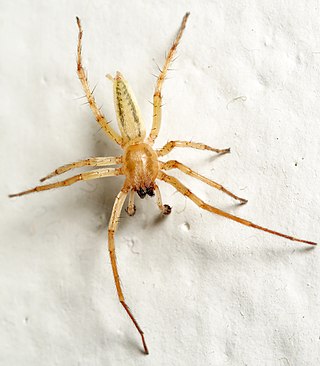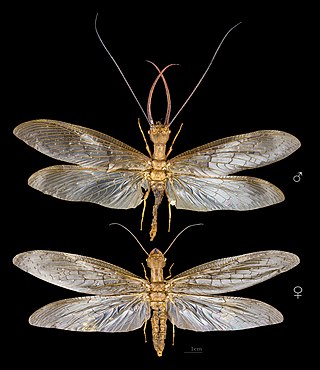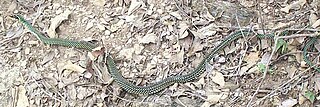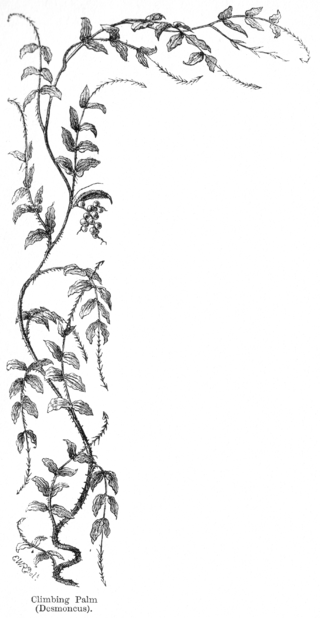
Anyphaenidae is a family of araneomorph spiders, sometimes called anyphaenid sac spiders. They are distinguished from the sac spiders of the family Clubionidae and other spiders by having the abdominal spiracle placed one third to one half of the way anterior to the spinnerets toward the epigastric furrow on the underside of the abdomen. In most spiders the spiracle is just anterior to the spinnerets. Like clubionids, anyphaenids have eight eyes arranged in two rows, conical anterior spinnerets and are wandering predators that build silken retreats, or sacs, usually on plant terminals, between leaves, under bark or under rocks. There are more than 600 species in over 50 genera worldwide.

Chusquea is a genus of evergreen bamboos in the grass family. Most of them are native to mountain habitats in Latin America, from Mexico to southern Chile and Argentina.

The rufous-browed peppershrike is a passerine bird in the vireo family. It is widespread and often common in woodland, forest edge, and cultivation with some tall trees from Mexico and Trinidad south to Argentina and Uruguay.

Corydalus is a genus of large flying insects in the Corydalidae family, commonly known as dobsonflies. They are endemic to North, Central and South America and there are about 35 known species. Members of the genus have wing lengths of up to 85 millimetres. They are sexually dimorphic, with the males having large mandibles used to grasp the females during mating while the females have smaller jaws. The larvae are known as hellgrammites and are aquatic predators.

Rauvolfia is a genus of evergreen trees and shrubs, commonly known as devil peppers, in the family Apocynaceae. The genus is named to honor Leonhard Rauwolf. The genus can mainly be found in tropical regions of Africa, Asia, Latin America, and various oceanic islands.

Pouteria is a genus of flowering trees in the gutta-percha family, Sapotaceae. The genus is widespread throughout the tropical Americas, with outlier species in Cameroon and Malesia. It includes the canistel, the mamey sapote, and the lucuma. Commonly, this genus is known as pouteria trees, or in some cases, eggfruits.
Symbolia is a genus of flies in the family Dolichopodidae. It is distributed in the Neotropical realm.

Drymobius is a genus of colubrid snakes commonly referred to as neotropical racers, which are endemic to the Americas. There are four species recognized in the genus.

Lyssomanes is a spider genus of the family Salticidae, ranging from South and Central America, up to the southern United States.

Desmoncus is a genus of mostly climbing, spiny palms native to the Neotropics. The genus extends from Mexico in the north to Brazil and Bolivia in the south, with two species present in the southeastern Caribbean.

Oenocarpus is a genus of pinnate-leaved palms (Arecaceae) native to Trinidad, southern Central and tropical South America. With nine species and one natural hybrid, the genus is distributed from Costa Rica and Trinidad in the north to Brazil and Bolivia in the south.

Ateuchus is a genus of some 100 species of New World scarab beetles (Scarabaeidae) in the subfamily Scarabaeinae. They are found mainly in the Neotropics.

Achradocera is a genus of flies in the family Dolichopodidae. It is distributed in the Nearctic and Neotropical realms as well as in Polynesia. Several Afrotropical species were also placed in the genus, but in 2018 they were transferred to Chrysotus. Achradocera was formerly considered a subgenus of Chrysotus, but was restored as a separate genus by Harold E. Robinson (1975).
Coeloglutus is a genus of flies in the family Dolichopodidae. It is known from Guatemala, Ecuador, El Salvador, the Lesser Antilles, Puerto Rico, Costa Rica, Venezuela, Bolivia, Panama and Peru, and contains only one species, Coeloglutus concavus.
Neotonnoiria is a genus of flies in the family Dolichopodidae. It is known from Brazil, Panama, Costa Rica and Peru, and contains only one species, Neotonnoiria maculipennis. The genus was originally named Tonnoiria by Octave Parent in 1929; however, this was preoccupied by TonnoiriaMalloch, 1929, so it was renamed to Neotonnoiria by Harold E. Robinson (1970).

Neurigona is a genus of flies in the family Dolichopodidae. It is a large genus, with over 150 known species.
Chespiritos is a genus of flies of mostly neotropical distribution, belonging to the family Sphaeroceridae.
Lyroneurus is a genus of flies in the family Dolichopodidae. It includes 17 species distributed in the Neotropical realm. It was formerly treated as a subgenus of Diaphorus; more recently Lyroneurus has been treated as a synonym of Chrysotus, but Capellari & Amorim (2010) maintains it as a distinct genus noting that Chrysotus is possibly paraphyletic.
Dactylomyia is a genus of flies in the family Dolichopodidae.












